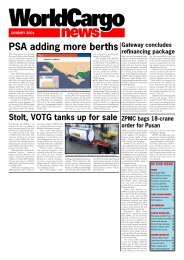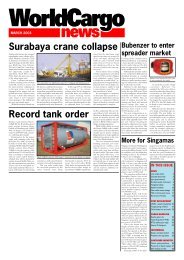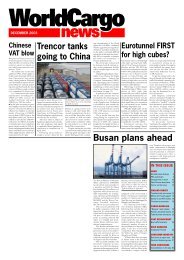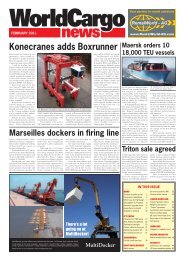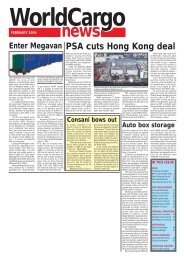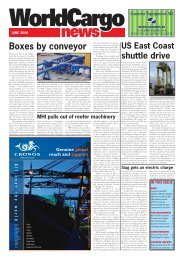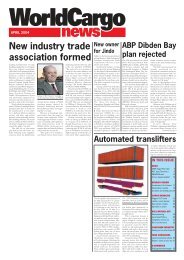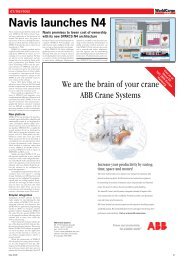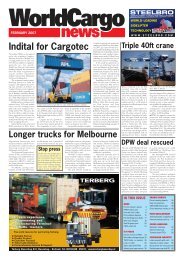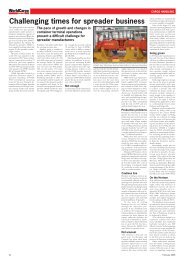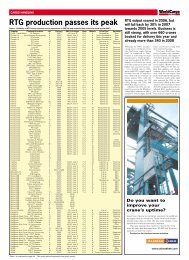Tanjung Priok super port - WorldCargo News Online
Tanjung Priok super port - WorldCargo News Online
Tanjung Priok super port - WorldCargo News Online
Create successful ePaper yourself
Turn your PDF publications into a flip-book with our unique Google optimized e-Paper software.
INSURANCE<br />
Club launches container cover<br />
Piracy moves<br />
to menace<br />
West Africa<br />
The hijacking of the German fully cellular,<br />
2008-built containership CITY OF<br />
XIAMEN in late April served to illustrate<br />
that the piracy flashpoint has moved from<br />
Somalia, where incidents have shown a<br />
big reduction, to West Africa. The growing<br />
number of attacks and successful<br />
hijackings in the Gulf of Guinea are pushing<br />
up insurance costs and damaging and<br />
disrupting trade, and “insider complicity”<br />
is suspected. A re<strong>port</strong> was published by<br />
worldcargonews.com on 12 April 2012 (“Pirates<br />
step up West African attacks”).<br />
According to a new Reuters re<strong>port</strong>,<br />
the International Maritime Bureau, the<br />
industry watchdog, said that 14 heavily<br />
armed pirates attacked the vessel and<br />
breached its citadel. The pirates took five<br />
officers and crew captive, including the<br />
master, before escaping with cash and the<br />
crew. The whole incident remained<br />
something of a mystery at the time of<br />
writing, with the ship still anchored off<br />
Equatorial Guinea and relatives of the<br />
crew unable to obtain any information.<br />
Ransom demands<br />
But it can be said that the pirates operating<br />
in this area are increasingly focusing<br />
on taking hostages in order to extract ransom<br />
payments. In a region where political<br />
uncertainty and military actions are<br />
documented in the media almost daily,<br />
there is a grey area between the motives<br />
of pirates and terrorists on land pulling<br />
the strings, some observers assert.<br />
It is interesting to note that at the end<br />
of 2012 the first boxship with a built-in<br />
citadel was delivered to its owners, Eastern<br />
Mediterranean Maritime in Greece.<br />
Two sister ships will follow the<br />
1,700TEU TZINI. As an anti-piracy measure,<br />
a citadel was incorporated in the<br />
vessel’s design, and was fitted in the steering<br />
gear room. Inside, the crew have control<br />
capability of the vessel, emergency<br />
rations, safe air supply, CCTV control,<br />
and good external communications.<br />
Could this be the way ahead for<br />
containerships, at least for smaller types<br />
Released hostages<br />
Meanwhile, some of the seafarers who<br />
were held hostage for almost three years<br />
after the general cargo ship ICEBERG was<br />
hijacked by Somali pirates were pictured<br />
in Mumbai at a meeting of the International<br />
Trans<strong>port</strong> Workers’ Federation’s<br />
maritime safety committee. Those present<br />
heard of the appalling treatment suffered<br />
by the 23 crew members during their long<br />
ordeal, including beatings and torture.<br />
One crewman died as a result of malnutrition,<br />
and the seamen had to watch<br />
their officers being hung upside down<br />
and tortured, and the ears of a senior officer<br />
being chopped off for failing to<br />
move the ship.<br />
From mid-May, a new motion picture,<br />
A Hijacking, is on general release, inspired<br />
by real events. The film has been widely<br />
praised with one critic telling audiences to<br />
prepare for nerve-shredding tension.<br />
The ROZEN, seen on screen, was actually<br />
hijacked by Somali pirates in 2007, and<br />
some of its crew are also in the film, which<br />
was shot on the cramped interior of the<br />
vessel off the Somali coast. ❏<br />
Norway’s Gard P&I Club has introduced<br />
the latest product to its range, a property<br />
policy to cover damage to or loss of containers<br />
– on and off the ship. Launched in<br />
March, the Container and Equipment<br />
Cover (CEC) was developed to meet the<br />
needs of container owners, operators or<br />
lessees, typically liner vessel operators.<br />
CEC will respond to theft, loss of or<br />
damage to containers, flatracks, roll trailers<br />
and similar equipment used for carrying<br />
goods. In addition, it covers a container’s<br />
contribution to general average.<br />
CEC complements liability insurances<br />
like P&I and the Comprehensive Carriers<br />
Cover. But while marine liability insurance<br />
is normally closely linked to the<br />
insured ship, the main focus of CEC is<br />
the cargo carrying equipment.<br />
CEC is not restricted to sea trans<strong>port</strong>.<br />
For example, if a box sustains damage<br />
whilst being stored at a shoreside terminal<br />
or during inland trans<strong>port</strong> by truck,<br />
the cover may still respond.<br />
The limit of cover is tailored according<br />
to the insured’s needs, with a maximum<br />
limit of US$50M for all claims arising<br />
out of one and the same incident.<br />
Where replacement and insured values are<br />
different, CEC covers the lesser value.<br />
Gard’s CEO Claes Isacson said that<br />
since the company provided P&I and/or<br />
marine insurance to more than half of the<br />
world’s container fleet, extending the<br />
product <strong>port</strong>folio to cover the containers<br />
themselves was a natural next step.<br />
Exposure<br />
He added: “Liner operators take responsibility<br />
for the overall trans<strong>port</strong> cost, time,<br />
delivery detail and quality of their clients’<br />
trans<strong>port</strong> chains. Thus, they are increasingly<br />
exposed to a wide range of risks in<br />
their daily operations relating to the trans<strong>port</strong>ation,<br />
storage and handling of cargo.<br />
Our ability to offer seamless coverage is a<br />
strong proposition.”<br />
The new CEC cover is basically a<br />
property insurance. What happens inside<br />
the container while it is on the move remains<br />
of pressing concern to all P&I clubs.<br />
<strong>WorldCargo</strong><br />
news<br />
Bad stowage<br />
Meanwhile, the UK Club has reiterated<br />
that one of the main contributory causes<br />
of container cargo damage is bad stowage.<br />
“It would seem we have merely shifted the<br />
cargo problem further back up the transit<br />
chain,” was its caustic remark.<br />
A considerable pro<strong>port</strong>ion of the UK<br />
club’s time is taken up handling container<br />
cargo claims where 25% of the damage is<br />
physical, 14% temperature-related, 11%<br />
boxes lost overboard, 9% theft and 8%<br />
shortage.<br />
The club reckons that shore error now<br />
accounts for around 27% of large container<br />
claims, compared to 19% for all<br />
types of cargo claims. Tie this in with bad<br />
stowage statistics and it seems to point to<br />
problems originating at stuffing.<br />
However, although it is a major<br />
cause of container cargo damage, said<br />
the club, it would be wrong to lay the<br />
origin of all container cargo claims on<br />
bad stowage alone, and it lists no fewer<br />
than 25 other reasons for damage. Its<br />
statistics show that container cargo<br />
claims it handles by vessel type now<br />
occupy the No. 3 slot (15%), after<br />
bulkers (28%) and dry cargo (25%).<br />
As a postscript, the TT Club estimates<br />
there are 95M loaded container movements<br />
a year. Because of the woes currently<br />
besetting the container trades, this<br />
number must be suspect, but in the long<br />
term it will rise exponentially. ❏<br />
May 2013 83



